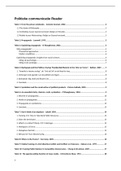Samenvatting
Summary of all the readings of week 4 (Rigthart, Kennedy, Oudenampsen, Steger & Roy chapter 1+6)
- Instelling
- Universiteit Van Amsterdam (UvA)
Summary of all the readings of week 4 from the first year sociology course 'Sociology of Institutions'.
[Meer zien]











